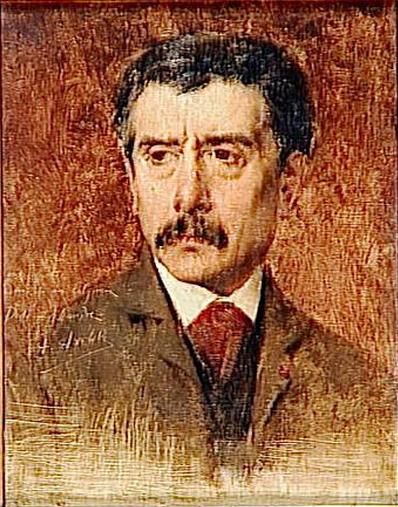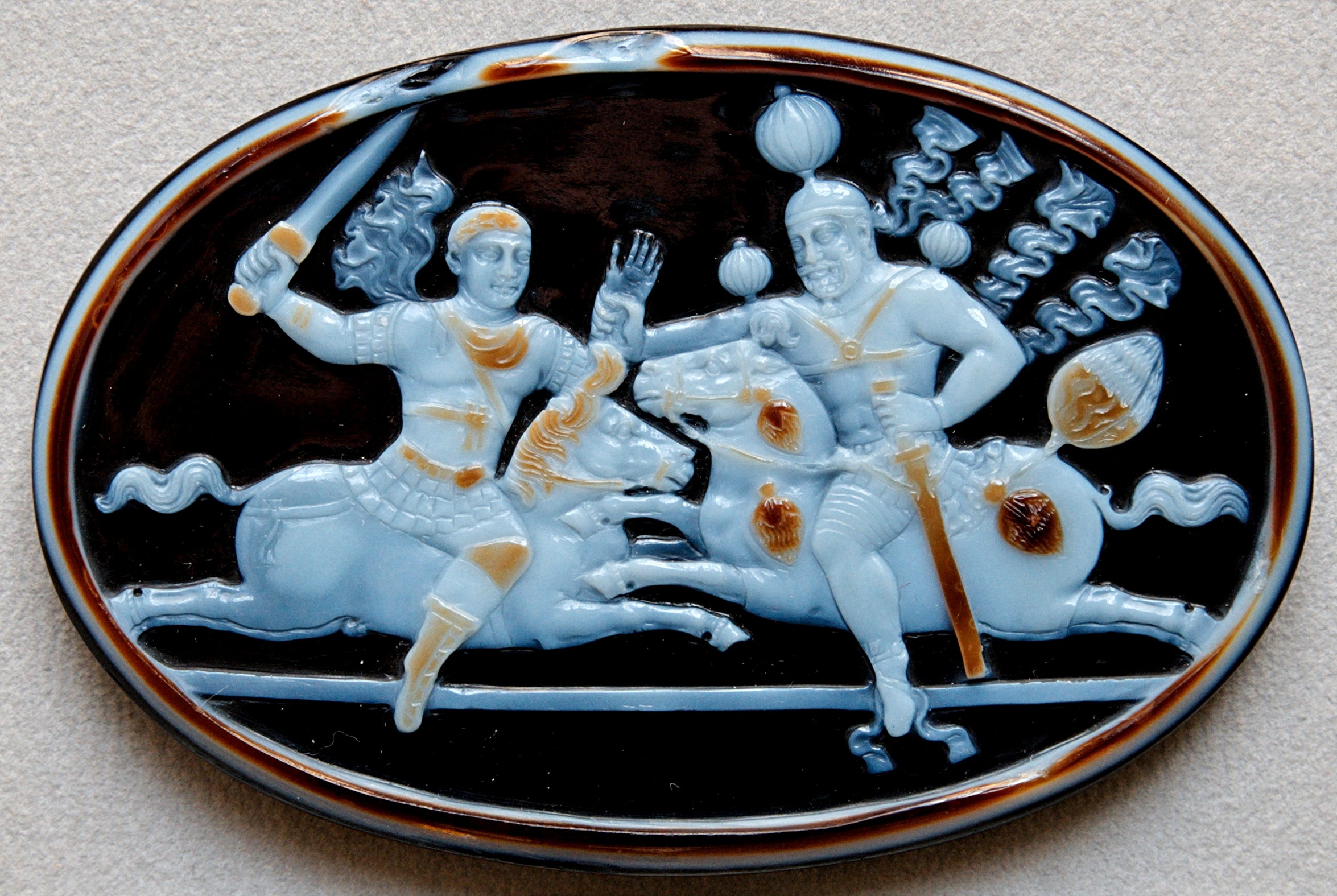|
Tarcisius
Tarsicius or Tarcisius was a martyr of the early Christian church who lived in the 3rd century. The little that is known about him comes from a metrical inscription by Pope Damasus I, who was pope in the second half of the 4th century. History The only positive information concerning this Roman martyr is found in a poem composed in his honour by Pope Damasus (366–384), who compares him to the deacon Saint Stephen and says that, as Stephen was stoned by a crowd, so Tarcisius, carrying the Blessed Sacrament, was attacked by a group and beaten to death. Nothing else definite is known concerning Tarcisius. Since Damasus compares him to Stephen, he may have been a deacon; however, a 6th-century account makes him an acolyte. According to one version of the detailed legend that developed later, Tarcisius was a young boy during one of the fierce 3rd-century Roman persecutions, probably during the reign of Emperor Valerian (253–259). One day, he was entrusted with the task of bringi ... [...More Info...] [...Related Items...] OR: [Wikipedia] [Google] [Baidu] |
Acolyte
An acolyte is an assistant or follower assisting the celebrant in a religious service or procession. In many Christian denominations, an acolyte is anyone performing ceremonial duties such as lighting altar candles. In others, the term is used for one who has been inducted into a particular liturgical ministry, even when not performing those duties. Etymology The word ''Wikt:acolyte, acolyte'' is derived from the Greek language, Greek word ἀκόλουθος (''akolouthos''), meaning an attendant, via Late Latin ''acolythus''. Eastern Christianity In the Eastern Orthodox Church, Eastern Orthodox and Byzantine Rite Eastern Catholic Churches, the nearest equivalent of acolyte is the altar server. At one time there was a rank of minor clergy called the ''taper-bearer'' (κηροφόρος) responsible for bearing lights during processions and liturgical Entrance (Liturgical), entrances. However, this rank has long ago been subsumed by that of the Reader (liturgy), reader and t ... [...More Info...] [...Related Items...] OR: [Wikipedia] [Google] [Baidu] |
San Silvestro In Capite
The Basilica of Saint Sylvester the First, also known as (, ), is a Roman Catholic minor basilica and titular church in Rome dedicated to Pope Sylvester I (d. AD 335). It is located on the Piazza San Silvestro, at the corner of Via del Gambero and the Via della Mercede, and stands adjacent to the central Post Office. Built in the 8th century as a shrine for the relics of the saints and martyrs from the Catacombs, the church is the national church of Great Britain. The Latin words "in capite" refers to the canonical title of Pope Sylvester the First, to which ''in capite'' means ''in First, in Chief, or in Head''. The basilica is also famous for a relic, a fragment of a head purported to be that of John the Baptist, kept in a chapel to the left of the entrance. A second Roman church dedicated to Pope Sylvester I is San Silvestro al Quirinale. The current Cardinal-Priest is Louis-Marie Ling Mangkhanekhoun, Apostolic Vicar of Vientiane. History The original church was built ... [...More Info...] [...Related Items...] OR: [Wikipedia] [Google] [Baidu] |
Altar Boy
An altar server is a lay assistant to a member of the clergy during a Christian liturgy. An altar server attends to supporting tasks at the altar such as fetching and carrying, ringing the altar bell, helping bring up the gifts, and bringing up the liturgical books, among other things. If young, the server is commonly called an altar boy or altar girl. In some Christian denominations, altar servers are known as acolytes. Latin Church The Second Vatican Council's '' Constitution on the Sacred Liturgy'' confirmed that altar servers featured among those who "exercise a genuine liturgical function" within services such as the Mass. According to the ''General Instruction of the Roman Missal'', "Mass should not be celebrated without a minister, or at least one of the faithful, except for a just and reasonable cause." While the function of altar server is commonly associated with children, it can be and is carried out by people of any age or dignity. The term "acolyte" As in ot ... [...More Info...] [...Related Items...] OR: [Wikipedia] [Google] [Baidu] |
Alexandre Falguière
Jean Alexandre Joseph Falguière (; also given as Jean-Joseph-Alexandre Falguière, or in short Alexandre Falguière) (7 September 183120 April 1900) was a French sculptor and painter. Biography Falguière was born in Toulouse. A pupil of the École des Beaux-Arts, he won the Prix de Rome in 1859; he was awarded the medal of honor at the Paris Salon in 1868 and was appointed Officer of the Legion of Honor in 1878. Falguière's first bronze statue of importance was ''Le Vainqueur au Combat de Coqs (Victor of the Cockfight)'' (1864), and '' Tarcisius the Christian Boy-Martyr'' followed in 1867; both were exhibited in the Luxembourg Museum and are now in the Musée d'Orsay. His more important monuments are those to Admiral Courbet (1890) at Abbeville and the famous Joan of Arc. Other works include ''Eve'' (1880), ''Diana'' (1882 and 1891), ''Woman and Peacock'' (a. k. a. '' Juno and The Peacock''), and ''The Poet'', astride his Pegasus spreading wings for flight. He sculpted ''T ... [...More Info...] [...Related Items...] OR: [Wikipedia] [Google] [Baidu] |
Saint
In Christianity, Christian belief, a saint is a person who is recognized as having an exceptional degree of sanctification in Christianity, holiness, imitation of God, likeness, or closeness to God in Christianity, God. However, the use of the term ''saint'' depends on the context and Christian denomination, denomination. In Anglican Communion, Anglican, Oriental Orthodox, and Lutheranism, Lutheran doctrine, all of their faithful deceased in Heaven are considered to be saints, but a selected few are considered worthy of greater honor or emulation. Official Ecclesiastical polity, ecclesiastical recognition, and veneration, is conferred on some denominational saints through the process of canonization in the Catholic Church or glorification in the Eastern Orthodox Church after their approval. In many Protestant denominations, and following from Pauline usage, ''saint'' refers broadly to any holy Christian, without special recognition or selection. While the English word ''saint'' ... [...More Info...] [...Related Items...] OR: [Wikipedia] [Google] [Baidu] |
Emperor Valerian
Valerian ( ; ; – 260 or 264) was Roman emperor from 253 to spring 260 AD. Valerian is known as the first Roman emperor to have been taken captive in battle, captured by the Persian emperor Shapur I after the Battle of Edessa, causing shock and instability throughout the Roman Empire. The unprecedented event and his unknown fate generated a variety of different reactions and "new narratives about the Roman Empire in diverse contexts". Biography Origins and rise to power Unlike many of the would-be emperors and rebels who vied for imperial power during the Crisis of the Third Century, Valerian was of a noble and traditional senatorial family. Details of his early life are sparse, except for his marriage to Egnatia Mariniana, with whom he had two sons: Publius Licinius Egnatius Gallienus (his co-emperor and later successor) and Licinius Valerianus. Valerian was consul for the first time either before AD 238 as a ''Suffectus'' or in 238 as an ''Ordinarius''. In 238 he was '' ... [...More Info...] [...Related Items...] OR: [Wikipedia] [Google] [Baidu] |
Eucharist
The Eucharist ( ; from , ), also called Holy Communion, the Blessed Sacrament or the Lord's Supper, is a Christianity, Christian Rite (Christianity), rite, considered a sacrament in most churches and an Ordinance (Christianity), ordinance in others. Christians believe that the rite was instituted by Jesus at the Last Supper, the night before Crucifixion of Jesus, his crucifixion, giving his Disciple (Christianity), disciples bread and wine. Passages in the New Testament state that he commanded them to "do this in memory of me" while referring to the bread as "my body" and the cup of wine as "the blood of my covenant, which is poured out for many". According to the synoptic Gospels, this was at a Passover meal. The elements of the Eucharist, sacramental bread, either Leavening agent, leavened or Unleavened bread, unleavened, and sacramental wine (non-alcoholic grape juice in some Protestantism, Protestant traditions, such as Methodism), are consecrated on an altar or a communio ... [...More Info...] [...Related Items...] OR: [Wikipedia] [Google] [Baidu] |
EWTN
The Eternal Word Television Network (EWTN) is an American basic cable television network which presents around-the-clock Catholic programming. It is the largest Catholic television network in America, and is purported to be "the world's largest religious media network", (and according to the network itself) reaching 425 million people in 160 countries, with 11 networks. The network was originally founded by Mother Angelica , in 1980 and began broadcasting on 15 August 1981 from a garage studio at the Our Lady of the Angels Monastery in Irondale, Alabama, which Mother Angelica founded in 1962. She hosted her own show, ''Mother Angelica Live'', until health issues led to her retirement in September 2001. As of 2017, Michael P. Warsaw, who is a consultant to the Vatican's Dicastery for Communications, leads EWTN. In addition to its television network, EWTN owns the '' National Catholic Register'' newspaper, which it acquired in January 2011, and Catholic News Agency. The net ... [...More Info...] [...Related Items...] OR: [Wikipedia] [Google] [Baidu] |
Catacombs Of San Callisto
The Catacomb(s) of Callixtus (also known as the Cemetery of Callixtus) is one of the Catacombs of Rome on the Appian Way, notable for containing the Crypt of the Popes (Italian language, Italian: ''Cappella dei Papi''), which once contained the List of extant papal tombs, tombs of several popes from the 2nd to 4th centuries. History The Catacomb is believed to have been created by future Pope Callixtus I, then a deacon of Rome, under the direction of Pope Zephyrinus, enlarging pre-existing early Christian Hypogeum, hypogea. Callixtus himself was entombed in the Catacomb of Calepodius on the Aurelian Way. The crypt fell into disuse and decay as the relics it contained were translation (relic), translated from the catacombs to the various churches of Rome; the final wave of translations from the crypt occurred under Pope Sergius II in the 9th century, primarily to San Silvestro in Capite, which unlike the Catacomb was within the Aurelian Walls. The Catacomb and Crypt were rediscover ... [...More Info...] [...Related Items...] OR: [Wikipedia] [Google] [Baidu] |
Relic
In religion, a relic is an object or article of religious significance from the past. It usually consists of the physical remains or personal effects of a saint or other person preserved for the purpose of veneration as a tangible memorial. Relics are an important aspect of some forms of Buddhism, Christianity, Islam, shamanism, and many other religions. ''Relic'' derives from the Latin ''reliquiae'', meaning "remains", and a form of the Latin verb ''relinquere'', to "leave behind, or abandon". A reliquary is a shrine that houses one or more religious relics. In classical antiquity In ancient Greece, a polis, city or Greek temple, sanctuary might claim to possess, without necessarily displaying, the remains of a venerated hero as a part of a Greek hero cult, hero cult. Other venerable objects associated with the hero were more likely to be on display in sanctuaries, such as spears, shields, or other weaponry; chariots, ships or Figurehead (object), figureheads; furniture such a ... [...More Info...] [...Related Items...] OR: [Wikipedia] [Google] [Baidu] |
Stoning
Stoning, or lapidation, is a method of capital punishment where a group throws stones at a person until the subject dies from blunt trauma. It has been attested as a form of punishment for grave misdeeds since ancient times. Stoning appears to have been the standard method of capital punishment in ancient Israel. Its use is attested in the early Christian era, but Jewish courts generally avoided stoning sentences in later times. Only a few isolated instances of legal stoning are recorded in pre-modern history of the Islamic world. In recent decades several states have inserted stoning and other ''hudud'' (pl. of ''hadd'') punishments into their penal codes under the influence of Islamist movements. These laws hold particular importance for religious conservatives due to their scriptural origin, though in practice they have played a largely symbolic role and tended to fall into disuse. The Torah and Talmud prescribe stoning as punishment for a number of offenses. Over the cent ... [...More Info...] [...Related Items...] OR: [Wikipedia] [Google] [Baidu] |
San Domenico Maggiore
San Domenico Maggiore is a Gothic architecture, Gothic, Roman Catholic church and monastery, founded by the friars of the Dominican Order, and located in the square of the same name in the historic center of Naples. History The square is bordered by a street/alleyway popularly called "Spaccanapoli (street), Spaccanapoli" (presently labeled via Benedetto Croce at this particular section of its considerable length) in the historic center of Naples. It was one of the three main east–west streets of the original Greek city of ''Neapolis''. To the east along Spaccanapoli, one reaches in a few blocks the Piazza of Gesu Nuovo, Naples, Gesu Nuovo and Santa Chiara, Naples, Santa Chiara. The Church of San Domenico Maggiore incorporates a smaller, original church built on this site in the 10th century, ''San Michele Arcangelo a Morfisa''. Charles II of Naples began the rebuilding that produced the Gotico Angioiano structure that comprises the present church. The work was done between ... [...More Info...] [...Related Items...] OR: [Wikipedia] [Google] [Baidu] |










